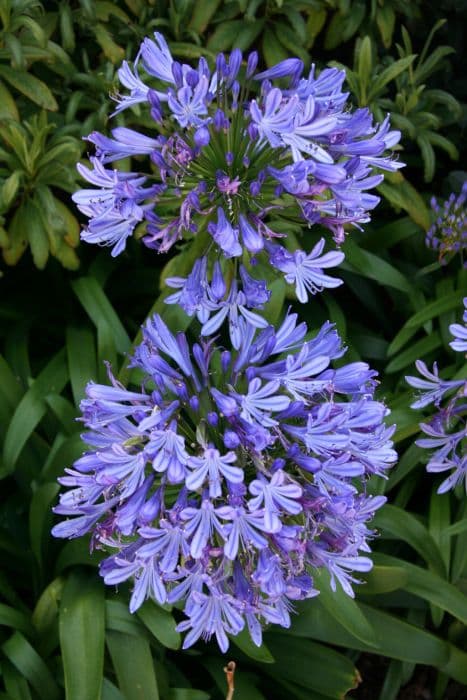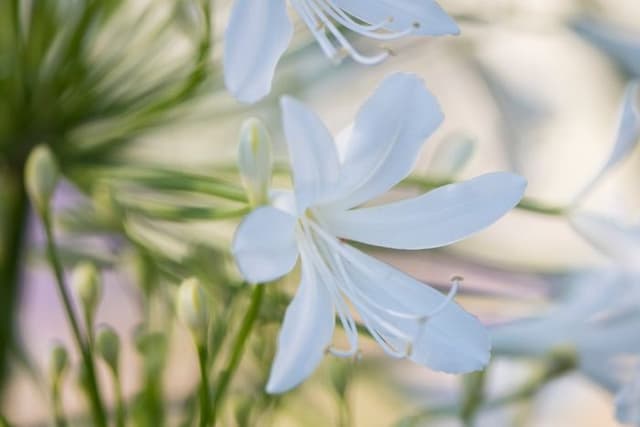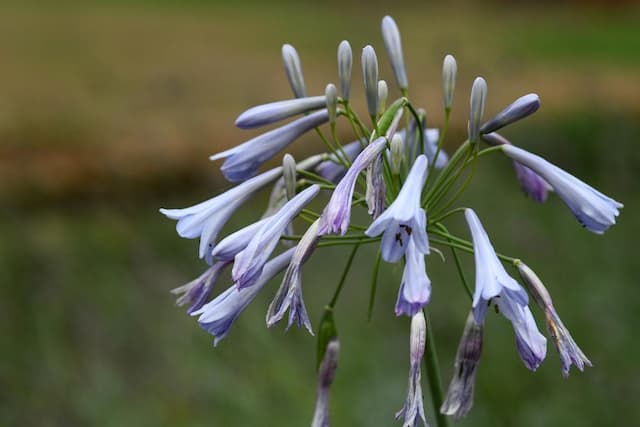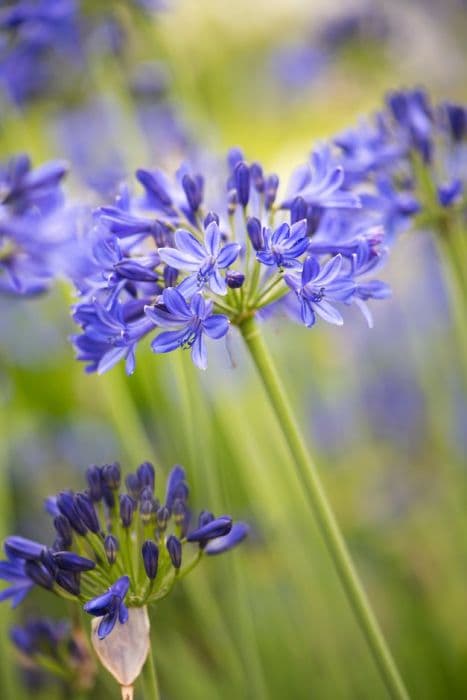Lily of the Nile Agapanthus 'Monique'

ABOUT
Agapanthus 'Monique' is characterized by its distinctive lush, strappy green leaves that form a dense clump, providing a lush backdrop to its stunning flowers. The flowering stems emerge from the center of the plant's foliage, rising above the leaves and culminating in a spherical cluster of trumpet-shaped flowers. Each individual blossom is a beautiful shade of blue to violet, depending on the maturity and environmental factors, and features a subtle stripe that accentuates its shape. The flowers are arranged in an eye-catching globular umbel, which adds a burst of color and an architectural element to the garden. This variety is valued for its robustness and the profusion of blooms that it produces, which are highly attractive to pollinating insects.
About this plant
 Names
NamesFamily
Amaryllidaceae.
Synonyms
African Lily, Lily of the Nile, Love Flower.
Common names
Agapanthus 'Monique'.
 Toxicity
ToxicityTo humans
The Lily of the Nile, though not considered highly poisonous to humans, does contain compounds that can cause harm if ingested. Eating parts of the plant may lead to symptoms like nausea, vomiting, and diarrhea. It is important to seek medical attention if someone has consumed any part of the Lily of the Nile, particularly concerning are the roots and sap, which contain the highest concentration of toxic substances.
To pets
The Lily of the Nile can be toxic to pets if ingested. The plant contains saponins and other compounds that can cause gastrointestinal upset, including vomiting and diarrhea. In more severe cases, the ingestion may lead to drooling, abdominal pain, and even tremors or cardiac issues. If you suspect your pet has ingested Lily of the Nile, it is important to contact a veterinarian immediately.
 Characteristics
CharacteristicsLife cycle
Perennials
Foliage type
Evergreen
Color of leaves
Green
Flower color
Blue
Height
2-3 feet (0.6-0.9 meters)
Spread
2-3 feet (0.6-0.9 meters)
Plant type
Bulb
Hardiness zones
8
Native area
South Africa
Benefits
 General Benefits
General Benefits- Ornamental Appeal: Agapanthus 'Monique' features striking blue to purple flowers that add aesthetic beauty to gardens and landscapes.
- Low Maintenance: This plant is known for being drought-tolerant and having relatively low water requirements once established.
- Long Blooming Season: It usually has a lengthy blooming period from early summer to fall, providing a long-lasting display of color.
- Attracts Pollinators: Its blooms are attractive to bees and other pollinators, which can help to pollinate nearby plants.
- Deer Resistant: Agapanthus 'Monique' is resistant to deer, making it an excellent choice for areas where deer browsing is a concern.
- Container Gardening: It can be grown in pots or containers, making it versatile for those with limited garden space or who wish to decorate patios or balconies.
- Coastal Tolerance: It is salt-tolerant and can be used in coastal gardens without fear of damage from salty air or soil.
- Soil Flexibility: Agapanthus 'Monique' can adapt to different soil types, though it prefers well-draining soil.
- Works as a Border Plant: It makes excellent borders and can be used to define garden spaces due to its clumping nature.
- Cut Flowers: The blooms make excellent cut flowers for vases and floral arrangements with their long stems and attractive flowers.
 Medical Properties
Medical PropertiesThis plant is not used for medical purposes.
 Air-purifying Qualities
Air-purifying QualitiesThis plant is not specifically known for air purifying qualities.
 Other Uses
Other Uses- Dye production: The flowers of the Agapanthus can be used to create a natural blue or purple dye for fabrics and artisan crafts.
- Garden borders: Due to their clumping nature and tall flower stalks, Agapanthus plants are often used to create striking garden borders.
- Erosion control: The thick roots of the Agapanthus can help to stabilize soil and prevent erosion on slopes or in areas prone to heavy rains.
- Focal points in container gardening: Their striking appearance makes them excellent as a centerpiece in large pots or containers for patios and balconies.
- Ink creation: Similar to their use in dyes, the natural pigments in the flowers could potentially be used to make colored inks for art or writing.
- Culinary decoration: While not commonly consumed, the flowers could be used as ornamental garnishes for high-end culinary dishes due to their vibrant color.
- Photography subject: The Agapanthus, with its attractive bloom, is a popular choice for photographers looking to capture the beauty of garden flowers.
- Wedding ceremonies: These flowers are often used in wedding bouquets or as decorations due to their elegant and romantic appearance.
- Bee and butterfly habitats: Agapanthus can attract pollinators like bees and butterflies, providing them with a valuable source of nectar.
- Companion planting: Agapanthus may be planted alongside other plants to take advantage of its ability to repel certain pests due to its strong scent.
Interesting Facts
 Feng Shui
Feng ShuiThe Lily of the Nile is not used in Feng Shui practice.
 Zodiac Sign Compitability
Zodiac Sign CompitabilityThe Lily of the Nile is not used in astrology practice.
 Plant Symbolism
Plant Symbolism- Love Letters: The name 'Agapanthus' is derived from the Greek words 'agape' (love) and 'anthos' (flower), symbolizing love. In the case of the variety 'Monique', this could be taken to represent a personal love note or an intimate message.
- Beauty: Agapanthus, commonly known as African Lily or Lily of the Nile, are known for their striking blue or purple flowers, and they symbolize beauty, as they are a highlight in any garden when in bloom.
- Endurance: African Lily is a hardy plant that can withstand harsh conditions, which makes them a symbol for endurance and survival through difficulty.
 Water
WaterAfrican Lily, commonly known as Agapanthus 'Monique', should be watered deeply to ensure the soil is thoroughly moistened, and any excess water should be allowed to drain away to prevent root rot. During the growing season in spring and summer, water the plant once a week with about 1 gallon per session for a medium-sized pot. Reduce watering frequency to every two to three weeks during the dormant winter months, ensuring the top inch of soil dries out between watering sessions.
 Light
LightAfrican Lily thrives best in full sun to partial shade conditions. Ideally, it should receive at least six hours of sunlight each day, which promotes healthy blooming. A spot that offers morning sunlight with some afternoon shade is also suitable, especially in regions with very hot summers.
 Temperature
TemperatureAfrican Lily prefers a temperature range between 50°F and 80°F for optimal growth. It can survive minimum temperatures down to 20°F, but the plant should be protected from frost. The ideal growing condition is within a temperate climate without extreme fluctuations in temperature.
 Pruning
PruningPrune African Lily after flowering to remove spent flower stalks and encourage new growth. Pruning should be done annually, preferably during late winter or early spring before new growth begins. Dead or damaged leaves can also be removed at this time to maintain the plant's appearance and health.
 Cleaning
CleaningAs needed
 Soil
SoilLily of the Nile 'Monique' thrives best in a well-draining soil mix that can retain some moisture—often a blend of loam, sand, and compost is ideal. It prefers a slightly acidic to neutral pH ranging from 6.0 to 7.0 for optimal growth.
 Repotting
RepottingLily of the Nile 'Monique' generally needs to be repotted every 2 to 3 years or when it becomes root-bound. Repotting in spring allows the plant to recover and grow actively during the growing season.
 Humidity & Misting
Humidity & MistingLily of the Nile 'Monique' is tolerant of a wide range of humidity levels but prefers moderate humidity. Average indoor humidity conditions are typically suitable for this plant.
 Suitable locations
Suitable locationsIndoor
Ensure bright, indirect light and consistent moisture for indoor Lily of the Nile.
Outdoor
Plant in partial sun, provide ample water during growing season for outdoor Lily of the Nile.
Hardiness zone
8-11 USDA
 Life cycle
Life cycleAgapanthus 'Monique', commonly known as Lily of the Nile, begins its life cycle as a seed, which upon germination gives rise to a seedling with characteristic strap-like leaves. As it enters the vegetative stage, the plant develops a strong root system and foliage, forming clumps that increase in size over time. The maturity stage is marked by the emergence of tall flower stalks, topped with clusters of blue or white funnel-shaped flowers during the summer months. After pollination, these flowers produce seed capsules, which on ripening release seeds to start the next generation. In the absence of seeding, the plant can also propagate vegetatively through the division of its clump, further extending its life cycle. As a perennial, Agapanthus 'Monique' enters a period of dormancy in colder climates during the winter, only to resume growth in the spring.
 Propogation
PropogationPropogation time
Late spring-summer
The most popular method of propagating the Agapanthus 'Monique', commonly known as the African Lily or Lily of the Nile, is by division. This is typically done in the spring or early summer just as the plant emerges from dormancy. To propagate by division, carefully dig up the clump of the African Lily, taking care to minimize root damage. Then, with a sharp knife or spade, divide the plant into smaller sections, each with a portion of the root system and one or more shoots. Replant the divisions immediately, positioning them at the same depth they were growing previously. Give them a thorough watering to help establish the divisions in their new locations. This approach allows the plant to recover during the growing season, ensuring a stronger start for the new plants.









